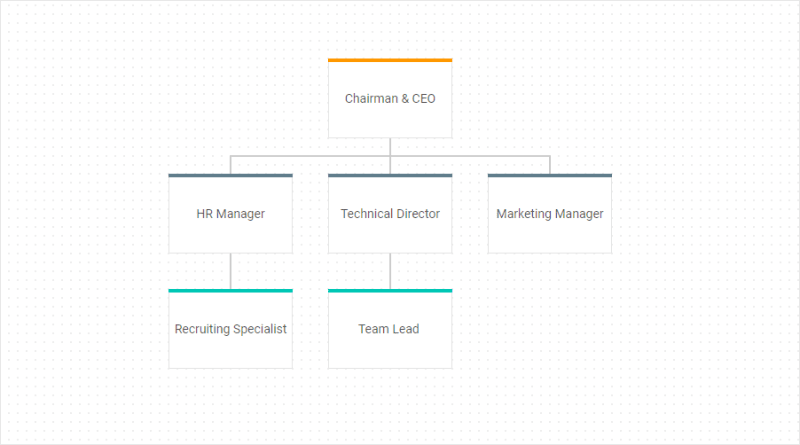Today, more and more businesses are investing in developing and integrating software tailored for managing HR processes. And it’s not surprising — such systems allow businesses to speed up and automate time-consuming and repetitive tasks so HR teams can focus on other vital activities, e.g. attracting top talent.
In this article, we’ll tell what an HRMS is for, why it includes org charts, and how to make a hierarchical diagram suitable for your company size using examples based on the DHTMLX JavaScript Diagram library.
Let’s get started!
What is a Human Resource Management System?
Going back to the 70s, HR management was a paper-centric function. Although some enterprises introduced automatic payroll and workforce management processes, most companies were still relying on manual entry to digitize reporting.
Starting from the late 90s, companies began using cloud-hosted HR management services. This trend made the technology more accessible, especially for small and remote teams that had to utilize online accounts on web-based portals to access their employees’ performance.
Over the past 20 years, a human resource management system (HRMS) or human resource information system (HRIS) has developed much as a field, making it indispensable in today’s enterprises. These systems enabled HR professionals to get rid of their traditional administrative work and have built them into companies’ strategic assets.
Modern HRMSs are designed to manage staff, but they have more comprehensive functionality than automated personnel recruitment systems. They are usually built with different modules that allow managing not only quantitative indicators but also qualitative indicators of personnel, including:
applicant tracking,
staff training,
benefits and compensation policies,
timesheets,
employee and performance management, etc.
One of the key functions of today’s HRM systems is the ability to generate interactive organizational charts. Let’s consider why they are so popular and how they can help your HR specialists.
What is an Organization Chart for?
Organization charts are often used company-wide as well as within specific departments and small teams. They visualize the company’s internal structure and usually provide information such as employees’ names, their specific job functions, relationships, and the hierarchy between them.
An org chart is good for a company to have better clarity on their roles and responsibilities. It helps an HR team to understand who reports to whom and who takes care of what department. Moreover, as a business grows, an org chart can be helpful for new hires as they find out who manages what processes at their company.
In short, an organizational chart is like a map that clearly explains how a company works and how its roles are organized.
As for larger organizations, this chart type is extremely useful as it allows easily visualizing their multi-layer hierarchical structure with a variety of roles. They can even go beyond and include business partners.
Another advantage of creating an org chart is that it helps identify departments or teams with open positions and potential gaps in the structure. Knowing your HR capacity will allow your HR managers to hire efficiently.
Org Chart Examples Based on Business Size
It’s quite obvious that your organization chart will vary depending on the size of your company.
For instance, in a small business with fewer than 100 employees or an early-stage startup, there might be one person who handles all department-related processes.
The following example includes a Chief Executive Officer (CEO), listed on the top, department managers and team leads that are listed below, and employees. The least important functions may be outsourced.
Midsize enterprises are those companies with 100 to 999 employees. There will also be included a CEO along with other officers. Each of them may have an assistant and manage a couple of general managers or team leads.
Therefore, you can build a functional org structure where to group all software engineers together in one department, put all of the QA engineers into a separate department, and gather all of the marketing specialists together in a third department.
A large organization with 1,000+ employees would maintain most of the roles in a midsized business but would likely alter the structure and assign fewer functions to each employee.
Summing up, in a dynamic business environment, organizational charts remain a reliable tool for visualizing the company’s structure and understanding the hierarchy of functions and responsibilities. Implementing such a useful feature to your HRM system allows your users to optimize organizational performance and employee satisfaction as well as easily determine the department’s growth opportunities.
The article is originally published on Medium.






Top comments (2)
Thanks for this insightful article on Human Resources diagrams - it's been a real eye-opener! 😊 I've been exploring ways to improve our HR processes, and your tips are incredibly valuable. I especially appreciate the practical guidance on building an effective HR diagram.
I also came across another fantastic resource recently that might complement this discussion. If you're interested in HR management software development, you should definitely check out this article: HRMs Software Development. It provides some great insights into how technology can transform HR processes.
Thanks again for your excellent work, and I look forward to more of your content!
Creating an effective Human Resources Diagram is essential for optimizing team dynamics. This visual representation outlines the structure of your workforce, ensuring efficient communication and collaboration. To build the most proper diagram for your team, consider incorporating elements such as roles, responsibilities, and reporting relationships. Additionally, include a section on interview questions and answers, emphasizing the importance of a well-structured hiring process in aligning team members with organizational goals. A thoughtfully designed HR diagram not only streamlines operations but also enhances the overall productivity and success of your team.